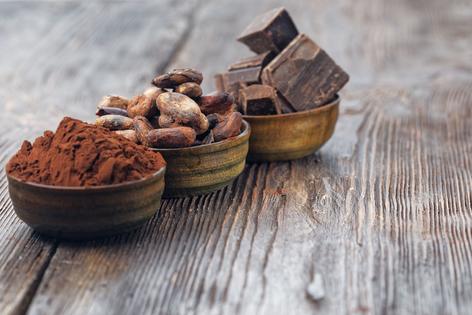Environmental Nutrition: Turn to dark chocolate for a heart-healthy treat
EN investigates the not so dark side of eating chocolate.
The mighty Mayans touted it as the "Food of the Gods," and ever since millions of palates have been held hostage to the seductive, silky ways of chocolate. Beyond its feel-good factor, partly in thanks to a mix of naturally-occurring stimulants, including caffeine and theobromine, modern research has wonderful news for chocoholics--this not-so-guilty pleasure may have some health benefits.
Deep chocolate health benefits
Habitual chocolate intake might be one weapon against heart disease and stroke, according to a British study involving nearly 21,000 adults. Chocolate intake appears to help improve artery functioning and reduce blood pressure levels. A 2016 study in the journal Appetite found a link between frequent chocolate consumption and improved brain functioning, including memory. This could make chocolate an ally for fighting cognitive diseases, such as Alzheimer's. What's more, a 2015 American Journal of Clinical Nutritioninvestigation discovered that indulging in chocolate at least twice per week may help lessen the risk for Type 2 diabetes.
What's so special about chocolate?
Chocolate is made from cocoa beans, including a paste containing cocoa solids and cocoa butter (indicated on labels as chocolate liquor or cocoa mass). Those cocoa beans are a source of antioxidants, including flavonoids and polyphenols, according to nutrition consultant Alissa Rumsey M.S., R.D. She says, "These antioxidants help our body fight off free radicals and repair damage." An ounce of dark chocolate (70 to 85 percent cacao) also supplies a range of nutrients, including fiber (12 percent DV), iron (19 percent DV), magnesium (16 percent DV), copper (25 percent DV), and manganese (27 percent DV). While chocolate is a source of the saturated fat stearic acid, Rumsey notes that, unlike some other saturated fats, it appears to have a neutral impact on cholesterol numbers.
So feel free to luxuriate in a piece of dark chocolate each day, but just keep a few facts in mind before you embrace your inner Willy Wonka.
Look for dark chocolate
Not all dark chocolate is that dark, thus won't pack much of a health punch. The problem is that there is no regulation over the term "dark chocolate", so chocolate products listing sugar before cocoa in their ingredients list can still tout themselves as being dark. "Choose chocolate that is at least 70 percent cocoa," advises Rumsey. This should be clearly stated on the package; if not, move on. Generally speaking, the higher the percentage the more cocoa-derived antioxidants you should get. However, a ConsumerLab.com investigation found the exact amount of flavonoids can vary from bar to bar, depending on factors such as cocoa bean variety and processing methods like fermentation, alkali exposure, and roasting. One thing that's clear: milk chocolate bars, which can have as little as 10 percent cocoa, are not a good source of antioxidants.
Train your taste buds for bitter
While antioxidants in dark chocolate make it a better-for-you treat, they do lend it a bitter flavor. So you may need to train your taste buds by starting off with bars that provide a lower cocoa percentage, say around 50 percent, and then gradually working your way up from there. Soon, you may find yourself craving a bar with upwards of 80 percent cocoa. Baking or unsweetened chocolate is pure cocoa, making it chockablock with antioxidants but crazy bitter, which is why it's most often added to recipes that also contain sugar. In addition, cocoa powder is the unsweetened substance left from pressed, ground cocoa beans; if not treated with alkali (Dutch-processed to make it milder in flavor) it's likely a great source of antioxidants.
Remember portion control
For all that is good about dark chocolate, it's still prudent to practice portion control to keep your daily calorie intake in check and lessen the risk for unwanted weight gain. A good rule of thumb is to limit yourself to about one ounce daily, which is roughly 150 calories. Eat too much and any potential health perks will be outweighed by chocolate's potential harm to the waistline. And a daily chocolate treat still doesn't negate the need to load up on vegetables and fruits as other sources of disease-fighting antioxidants.
Chocolate Nut and Fruit Clusters
Serves 12
6 ounces dark chocolate bars, chopped
1/2 teaspoon cinnamon
1/2 teaspoon ginger powder
1/8 teaspoon cayenne (optional)
1/2 cup shelled unsalted pistachios
1/2 cup dried cherries
Coarse salt (optional)
1. Melt chocolate in a heatproof bowl set over a pan of simmering water, stirring often.
2. Stir in cinnamon, ginger and cayenne (if using.)
3. Divide nuts and cherries among 12 paper-lined mini muffin cups and top with melted chocolate and coarse salt (if desired). Chill about 1 hour.
Nutrition Information Per Serving: 124 calories, 7 grams (g) fat, 4 g saturated fat, 13 g carbohydrate, 9 g sugar, 2 g protein, 2 g dietary fiber, 3 milligrams sodium.
(Environmental Nutrition is the award-winning independent newsletter written by nutrition experts dedicated to providing readers up-to-date, accurate information about health and nutrition in clear, concise English. For more information, visit www.environmentalnutrition.com.)







